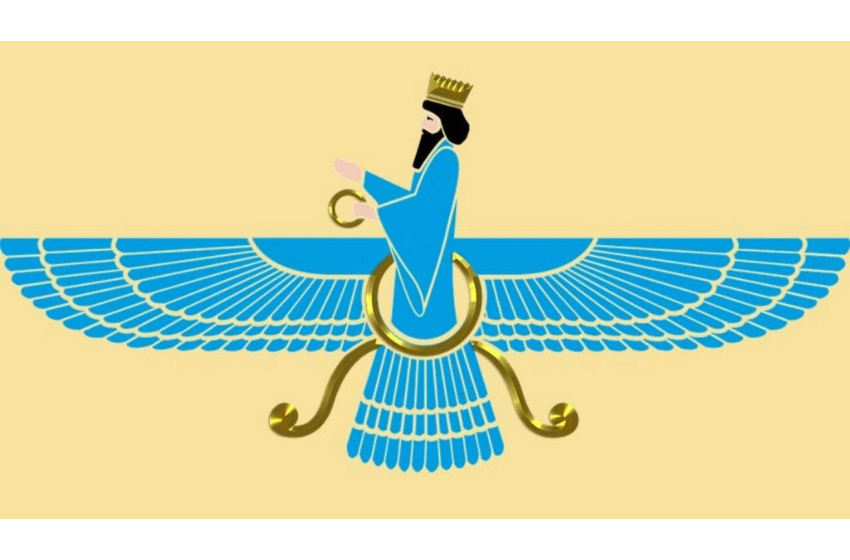The god of religion whose prophet was Zoroastrian: Who is Ahura Mazda?
Ahura Mazda is the supreme God in the Avesta, which includes the Gathas, claimed to have been revealed to Zoroaster, who is estimated to have lived in the 7th or 6th century BC.

The god of Zoroastrianism, representing goodness, was called Ahura Mazda (the judge lord) in Old Persian, the language of the sacred text of this religion, Avesta, and later this name was used in Middle Persian (Pahlavi), Uhurmezde (Hurmezd), Hurmuzd, New Persian. Urmezd turned into Ohrmazd or Ormazd in Western sources and Hormuz in Islamic sources.
Ahura Mazda is the supreme God in the Avesta, which includes the Gathas, claimed to have been revealed to Zoroaster, who is estimated to have lived in the 7th or 6th century BC. According to the statements in the present text of the Ghâthas, Zarathustra described and communicated a single, transcendent, and creative God. Ahura Mazda is a sovereign God who is aware of everything, sees and knows the future, and cannot be deceived by anyone, first of all, the creator of purity and righteousness, and the owner of justice.
Ahura Mazda also known as Oromasdes, Ohrmazd, Ormusd, Ahuramazda, Hoormazd, Harzoo, Hormazd, Hormaz and Hurmuz, is the creator deity and god of the sky in Zoroastrianism. He is the first and most frequently invoked spirit in the Yasna. The literal meaning of the word Ahura is "lord", and that of Mazda is "wisdom".
Zoroastrianism is the world's oldest monotheistic revelation religion, the religion of the 3 great Persian Empires from the 6th century BC to the 7th century AD, founded by Zoroaster in Iran 3500 years ago. Those who believe in this religion are called Zoroastrians and believe that after their bodily death, they will be resurrected and appear before Ahura Mazda where they will be questioned.
Zoroaster, an Iranian Prophet, was a religious leader who taught belief in an untouchable, unheard, and invisible existence. This being was Ahura Mazda; The only God of Reason, who creates all the good in the world. This name turned into Uhurmezde, Hurmuzd in Middle Persian, Urmezd in New Persian, Ohrmazd or Ormazd in Western sources, and Hormuz in Islamic sources. Ahura Mazda, who is accepted as God in Zoroastrianism, is symbolized as the "Lord of Reason", while Ehriman represents the forces of evil and the struggle between good and evil begins at this point.
Ahura Mazda is a sovereign God who is aware of everything, sees and knows the future, and cannot be deceived by anyone, first of all, the creator of purity and righteousness, and the owner of justice. This fight will end with Ahura Mazda's defeat of Ahriman on the last day of reckoning.
But until then it is the duty of every man to stand with the forces of good of Ahura Mazda and fight against the forces of evil. If a person acts like this, he will attain prosperity in this world and immortality in the next.
Unlike belief in God in the heavenly religions, Ahura Mazda does not judge people. All he wants is for goodness to spread all over the world and for people to be virtuous. There are two basic criteria for being virtuous. One of these criteria is knowledge and the other is love.
Zoroaster Becoming a Prophet
The Prophet Zarathustra saw Ahura Mazda through a vision he had when he was 30 years old. Zarathustra was considered an adult when he turned 15, as was common at the time. He grew up with difficulties. Throughout his life, he questioned concepts such as good, bad, cause and effect. As a result, he left his home and settled in a mountain to spend his 20-30 years. When Zarathustra was 30, he attended the spring festival as a member of his family, and one of his duties was to draw water from the deepest and purest part of the stream for the morning ceremony. It was at this time that he met the angel Vohu Mana on the Daytia River. The Being asked Zarathustra who he was and what was the most important thing in his life. To this Zarathustra said that he wanted above all to be righteous, pure, and wise. With this answer, he was able to learn about Ahura Mazda and his archangels, from which he learned principles that would lead to the religion later known as Zoroastrianism.
Although Zoroaster identifies Ahura Mazda as one, the Zoroastrian tradition eventually inherited some ideas from the polytheistic traditions that surrounded it. This is why Ahura Mazda is known for many emanations called Amesha Spentas (or "holy immortals").
How Is Ahura Mazda Depicted?
The Greek historian Herodotus (484 BC – c. 425) states that the Persians generally did not use symbols as part of their religious activities. This claim is backed up by the archaeological record and undoubtedly explains why there are so few well-known depictions of Ahura Mazda.
The worship of Ahura Mazda, with associated images, is also known to occur during the Parthian period of Persian history (250 BC-226 BC), but by the beginning of the Sassanid period (226-651 BC), the tradition seems to have disappeared. There are many symbols of Ahura Mazda from the Sassanid period. Other depictions depict Ahura Mazda emerging from the disc as a winged ring, accompanied by the feet and tail of a bird. While there are differing opinions about the meaning of these images, most scholars agree that the winged disc represents Ahura Mazda himself. Other paintings claiming to depict “Ohrmazd” show a long-crowned male figure. However, the rejection of anthropomorphic images of divine beings, including Ahura Mazda, became common in later Zoroastrianism, which was largely aniconic.
